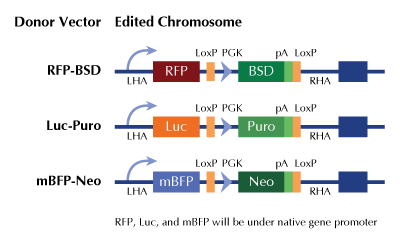CD38 Human Gene Knockout Kit (CRISPR)
CAT#: KN203179RB
CD38 - human gene knockout kit via CRISPR, HDR mediated
Functional Cassette: GFP-puro Luciferase-Puro mBFP-Neo
HDR-mediated knockout kit validation
USD 1,657.00
4 Weeks*
Specifications
| Product Data | |
| Format | 2 gRNA vectors, 1 RFP-BSD donor, 1 scramble control |
| Donor DNA | RFP-BSD |
| Symbol | CD38 |
| Locus ID | 952 |
| Components |
KN203179G1, CD38 gRNA vector 1 in pCas-Guide CRISPR vector KN203179G2, CD38 gRNA vector 2 in pCas-Guide CRISPR vector KN203179RBD, donor DNA containing left and right homologous arms and RFP-BSD functional cassette. GE100003, scramble sequence in pCas-Guide vector |
| Disclaimer | These products are manufactured and supplied by OriGene under license from ERS. The kit is designed based on the best knowledge of CRISPR technology. The system has been functionally validated for knocking-in the cassette downstream the native promoter. The efficiency of the knock-out varies due to the nature of the biology and the complexity of the experimental process. |
| Reference Data | |
| RefSeq | NM_001775, NR_132660 |
| UniProt ID | P28907 |
| Synonyms | ADPRC 1; T10 |
| Summary | The protein encoded by this gene is a non-lineage-restricted, type II transmembrane glycoprotein that synthesizes and hydrolyzes cyclic adenosine 5'-diphosphate-ribose, an intracellular calcium ion mobilizing messenger. The release of soluble protein and the ability of membrane-bound protein to become internalized indicate both extracellular and intracellular functions for the protein. This protein has an N-terminal cytoplasmic tail, a single membrane-spanning domain, and a C-terminal extracellular region with four N-glycosylation sites. Crystal structure analysis demonstrates that the functional molecule is a dimer, with the central portion containing the catalytic site. It is used as a prognostic marker for patients with chronic lymphocytic leukemia. Alternative splicing results in multiple transcript variants. [provided by RefSeq, Sep 2015] |
Documents
| Product Manuals |
| FAQs |
| SDS |
Resources
Other Versions
| SKU | Description | Size | Price |
|---|---|---|---|
| KN203179 | CD38 - human gene knockout kit via CRISPR, HDR mediated |
USD 1,657.00 |
|
| KN203179BN | CD38 - human gene knockout kit via CRISPR, HDR mediated |
USD 1,657.00 |
|
| KN203179LP | CD38 - human gene knockout kit via CRISPR, HDR mediated |
USD 1,657.00 |
|
| KN403179 | CD38 - KN2.0, Human gene knockout kit via CRISPR, non-homology mediated. |
USD 1,657.00 |
|
| GA100674 | CD38 CRISPRa kit - CRISPR gene activation of human CD38 molecule |
USD 1,657.00 |
{0} Product Review(s)
Be the first one to submit a review






























































































































































































































































 Germany
Germany
 Japan
Japan
 United Kingdom
United Kingdom
 China
China
